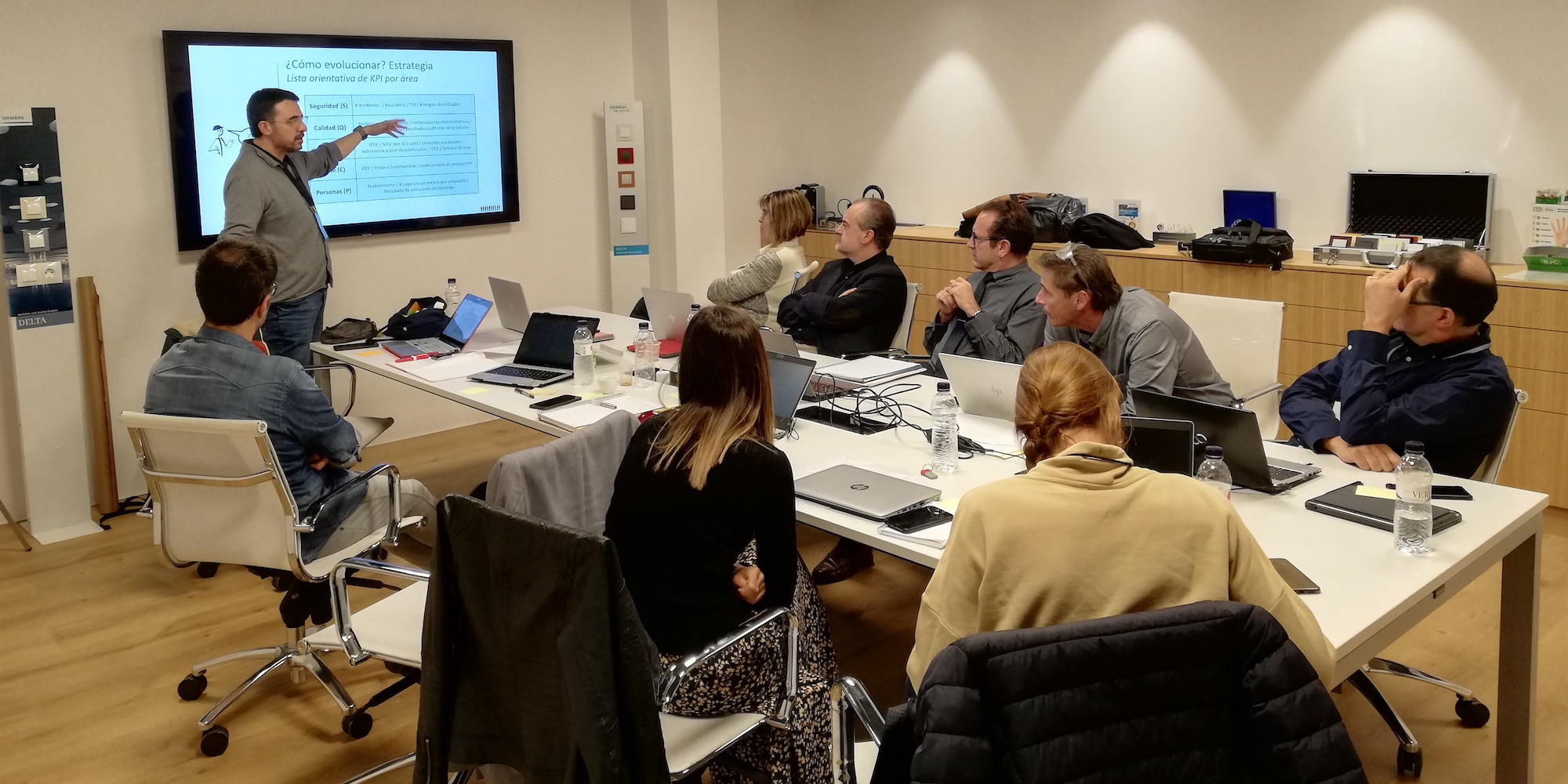
The role of HR in a lean transformation
FEATURE – The author outlines the role of HR in a lean transformation and explains why our ability to successfully turn around a business largely depends on activities in which HR participates.
Words: Severino Abad, Lean Coach, Instituto Lean Management – Barcelona
A lean organization considers people as its biggest asset, essential to achieve its objectives and to guarantee customer satisfaction. Such an accomplishment requires the active participation of every single member of the organization – everyone at their level but working towards a common goal. Indeed, the best lean organizations place great emphasis on human resources both to progress in their lean transformations and to ensure the long-term sustainability of changes and results.
This idea may sound obvious, but it is actually at odds with the reality of many lean turnarounds: in my experience, the HR department is often the area that most struggles to embrace the process of transformation. In fact, in those cases in which HR has become the sponsor of the transformation, results have been more easily sustained and change has taken roots in the DNA of the organization.
When you ask HR leaders about their reluctance towards lean transformations, the “excuses” you normally hear include:
- “We work with people. We never had to think about how we should organize our processes. In fact, in many occasions it’s really hard to identify those processes because every case is unique”;
- “This lean thing is for ‘operations’, but our job is to support operations so that they can reach their objectives”;
- “We normally deal with confidential data and need to adapt to each worker’s circumstances. We can’t make processes visible and it would be useless anyway”.
Yet, on the work of HR depends our ability to achieve a successful lean transformation, for example with regards to: the degree of development of human teams in a lean organization; measurement of follow-up of process performance; corporate communication; and individual communication. (These can also be used as indicators telling us where we are in our turnaround, by the way.)
DEVELOPMENT OF TEAMS
Without people, there are no processes. Their development, therefore, provides essential support to lean. But what does it actually mean to develop people?
- Teaching them the principles and tools they need to solve the problems that customers (both internal and external) experience day after day. In so doing, teams are empowered to tackle the daily challenge of achieving their objectives – as opposed to simply complying to orders.
- Contextualizing the history of the organization and draw parallels with that of Toyota, understanding that its principles and tools were created out of the necessity to overcome difficulties and obstacles. This, in turn, will teach us to face problems in a structured, scientific way rather than simply scramble to put a patch on them (which is often not enough to prevent them from reappearing).
- Communicating with them using a specific language but ensuring they understand the meaning behind the concepts. It’s fantastic to hear front-line workers talk about concepts like takt time, cycle time, lead-time, Kanban, just-in-time or poka-yoke, so long as they truly understand what they are.
- Promoting teamwork so that success stems from synergies among individuals and not from the ingenuity of a few members or experts. This way, respecting others and considering how our work impacts them become second nature.
- Teaching them to reveal problems, to ask for help when they are struggling to achieve their goals and recognize we don’t always an answer for everything. As John Shook once told us, “Don’t be afraid to admit when you don’t know. ‘I don’t know’ is a fine answer.”
- Teaching them the discipline and empowerment required to follow and improve standards.
PERFORMANCE INDICATORS
It’s fundamental to track and communicate the indicators of process performance and customer satisfaction at all times.
- In a lean culture, everyone in the business believes in the measurement system in use. Data needs to be available to everyone all the time. We can’t afford to not define what we need measure and how, who measures and when if we want a system that is self-sustain and that people can get behind.
- KPIs will be managed regularly, moving away from those that have sophisticated names or have nothing to do with the day-to-day of workers. Moreover, people need to recognize these indicators and try to improve them. Of course, this requires translating the company’s strategic performance indicators into individual ones – at all levels of the business (the work of hoshin kanri). Discrepancies between strategic and individual KPIs generates a gap that is hard to address and typically creates frustration in people.
- It’s important to align the speed of HR initiatives to the speed at which the data these initiatives are based on is captured. A couple of examples? It makes no sense to pay incentives every six months or once a year if the performance of processes is assessed daily or hourly. Similarly, why do we ask for daily suggestions from staff if we can only evaluate them monthly?
CORPORATE COMMUNICATION
Communication across the organization plays a vital role explaining the obstacles and difficulties the business is facing, as well as its successes.
- It’s important to communicate the mission, vision and values (what lean thinking identifies through the True North informing all the strategic decisions the business has to make) of the organization, which ideally everyone has to share. This normally entails going through a number of changes – more or less profound – across the business and at leadership level. These have to be communicated clearly and explicitly to ensure workers have no problem understanding the change they’ll witness in the company’s management team. Change affects everyone and everyone has to be aware of it. That’s why it’s important to create an environment of continuous learning in which change never stops.
- We are used to identify lean organizations for their focus on flow and value stream thinking, which allows them to provide customers with the value they want. This principle “crosses” any kind of organizational structure, both in terms of activities and hierarchy.
- Communication needs to be vertical and bidirectional, but also horizontal (across the different department making up a company, which often find themselves separated by invisible and impenetrable walls). It has to flow smoothly from where the information is generated to where it is needed; any interruption in this flow will impact the overall flow of the business and its main activities.
- We also need to be careful when we share motivating messages, such as “We are going to win this battle”, in the face of a difficulty. The message in itself is not a problem, but as leaders we cannot accept the presence of a problem and simply appeal to people’s sense of pride and rely on their ability to make an effort without engaging in a participative and transparent process of problem solving.
- We can’t abuse generalist information that “works for everyone”, which actually alienates individuals with a false image of “unity” that we want to present. Why not use other basic lean principles like single piece flow for an individual to individual communication?
INDIVIDUAL COMMUNICATION
This aspect of the work of HR focuses on communicating to the worker her specific role in the transformation or in the sustainment of the organizational model.
- Every member of the organization has to know not only what the organization is trying to achieve, but also what her contribution to the company’s success is, what’s expected of her. Without this, how can we expect them to commit and get involved in the improvement work? How can we obtain their best performance?
- Breaking the huge barrier that exists between different hierarchical levels is essential to achieve the desired results. It won’t be possible until front-line workers stop seeing that decisions come “from above”. A characteristic of lean businesses is the proximity of leaders to front-line workers through practices like gemba walks, A3 presentations, and so on.
- Another key moment in which individual communication has to be different is whenever there is a change in the role or destination of an individual. This change has to be communicated with transparency to everyone, which of course requires mutual trust. I remember a case I witnessed, in which a colleague was promoted from Logistics Manager to Operations Manager (which gave him responsibility over production and maintenance) due to his performance in his area of work and the needs of the other areas. Well, this decision wasn’t communicated to those impacted by the change. The result? Nobody recognized his authority and people started to boycott him. This person was responsible for an area (he reported to the Operations Director) without being able to act on his position. Such poorly managed situations can easily destroy whatever trust was gained in an organization (like in the case mentioned) and cause processes to stop working right away.
- Another important feature of lean organizations is the feedback loops that follow suggestions made at every level. To guarantee people’s engagement and empowerment means to provide them with feedback on their performance to both ensure they are aligned with the company’s True North (reinforcing those behaviors) and to alert them when they are not in line with the company’s culture or organization (giving them the chance to correct them before they cause an even more serious misalignment).
- The importance of recognizing and celebrating the successes achieved thanks to kaizen can’t be stressed enough. This routine differentiates lean organizations, in that it allows leaders to “show respect” and recognize the effort the team has made to achieve that success. Critically, what matters most is not the scale of the success, but its repeatability.
THE ROLE OF HR
For all the characteristics we have described above, it is clear that the participation of HR in a lean transformation and their work to safeguard its sustainability is of the utmost importance.
In those businesses in which HR has become a partner or even a sponsor of the lean transformation, the results have been very positive and have showed up sooner than in other businesses (check out these two Planet Lean articles – here and here). This department can contribute in a number of ways:
- Create a lean culture and achieve the full alignment of workers with the company’s True North.
- Keep alive the sense of belonging to the organization focusing on the experience of workers in the workplace – for example by means of: professional behaviors in dealing with the needs of workers on the job (related to their position or potential conflict with others); a humane approach to dealing with a person’s emotional state (think about illness or family issues) and the recognition that they might need support even outside of the workplace; the identification of the business in the uniform people are given; flexibility in the creation of shift and in offering remote working to help people balance working and private lives; working to make the workplace feel more like family, for instance with recreational activities or company picnics.
- Make sure the right people are hired. It’s part of HR’s remit to design and execute plans for the development and improvement of people’s skills and to intensify the connection between corporate goals and the contribution to it that each person can provide.
- Draw and execute processes for the development of leadership skills at all levels that ensure the creation of an “ecosystem that allows everyone in it to develop themselves to the fullest, through experimentation and learning, in a bid to achieve the full satisfaction of the customer sustainably and in accordance with the strategic plan designed by the organization”. (More here.) https://planet-lean.com/gemba-walks-common-mistakes/.
- Generate information campaigns aimed at reinforcing certain behaviors in the organization that contribute directly to the protection of the worker, the safeguarding of customer value or even the profitability of the business. It’s very important that these channels of communication get as close as they can to the workers and transmit to them, especially at difficult times, a sense of calm and control over the decisions that are being made. The worker has to feel safe, protected, and well-informed.
- Establish a transparent policy of rewards and recognitions. The salary structure of the organization has to be fair for people at all levels as well as known and understood by everyone. Attention needs to be paid to the “emotional salary” of each worker.
- Ensure people work in a professional working environment that emphasizes teamwork and the role of managers as support figures who help workers meet the challenges posed by the customers. In such a working place, professional bonds are tightened so that everyone’s roles and responsibilities are clear and can be carried out without making other people’s lives harder. Moreover, leaders should have regular contact with staff. It’s also necessary to design a measuring system based on objective and transparent indicators that can be used to detect anomalies before they become too big to tackle. Such a system can also provide up-to-date information to quickly assess the impact of any organizational or strategic change.
- Help the top management team to develop their own managerial skills and understanding of Lean Thinking so that they lead the transformation as effectively as they can – and in unison with the rest of the business.
- Try to retain talent. Of course, this is not just a prerogative of HR, but there is no doubt this department can provide great help here by: providing custom-made development plans for operational people as well as leaders (based on the profile and daily necessities of each person); creating development plans that aim to multi-skill workers to better adapt to changes in demand, absenteeism or planning of summer vacations (the idea is to make unpredictable situations more predictable); facilitating learning across the organization so that mistakes become opportunities to advance knowledge and identify countermeasures (rather than a reason for punishment); developing and assigning roles and responsibilities based on the performance of each person (for instance, asking a worker with teaching potential to develop the skills of new hires); provide a context in which any worker can effectively advance her skillset.
- Find and recruit new employees who can adapt to the operational needs of the business. This means being sure you can hire the right candidate in the timeframe the company actually needs her(which is typically much shorter than what the average HR department can offer) and that she can work when company needs her (with the skills that are expected of her). This can be achieved in different ways: a standardized advance process for new candidates (why not preselecting potential ones? After all, companies normally know their needs well before it’s time to recruit); a standard process of questions and tests for each case, not just to assess knowledge but also to gauge attitudes, behaviors and predisposition for change (this process should evolve until it fully adapts to the specific needs of the organization or the job post); a complete onboarding process that includes anything from safety norms to the use of PPE, from cultural aspects like lean principles to the use of TWI and dojos to help the person acclimatize and learn about the work.
- Streamline the suggestions system and other ways for workers to contribute ideas, so that people often receive feedback (whether positive or negative).
- Participate in the translation of strategic objectives into operational targets for each worker and turn them into action plans whenever necessary, in a way that their attainment becomes a part of everyone’s daily work.
- Develop agile mechanisms to make it easier for people to adapt more naturally to new changes (which seem to be each time more frequent), through approaches based on continuous learning and transparent communication.
- Even laying people off – something that should always be the last resort for a lean business – requires a careful and professional approach that accompanies the worker (and his colleagues) through such a difficult situation. Ignoring this can cause anxiety, distrust and alienation in workers, who will consequently begin to act like an invisible obstacle that makes it impossible to achieve anything.
The participation of HR is critical to achieve and sustain a lean transformation. I encourage those managing HR departments to get involved with it from the very beginning, helping to build a solid, adaptive, agile organization that is capable of facing up to any challenge thrown at it. It’s our responsibility to be as prepared as we can.
THE AUTHOR

Read more


INTERVIEW – Planet Lean speaks with David Mann about the importance of combining the lean production and the lean management systems – the tools and the culture – to create sustainable results.


FEATURE – This Siemens Group-owned medium-sized manufacturer of electrical low-voltage devices has been experimenting with hoshin kanri. In this article, they share their experience and lessons learned.


FEATURE – The pandemic has brought back into the spotlight the common misconception that Just-in-Time causes disruption when spikes in demand occur. Torbjørn Netland debunks the myth.


INTERVIEW – Christleton Learning Trust in the UK is running several lean experiments across its three schools. We spoke with its CEO, who told us how coaching is supporting the transformation.

